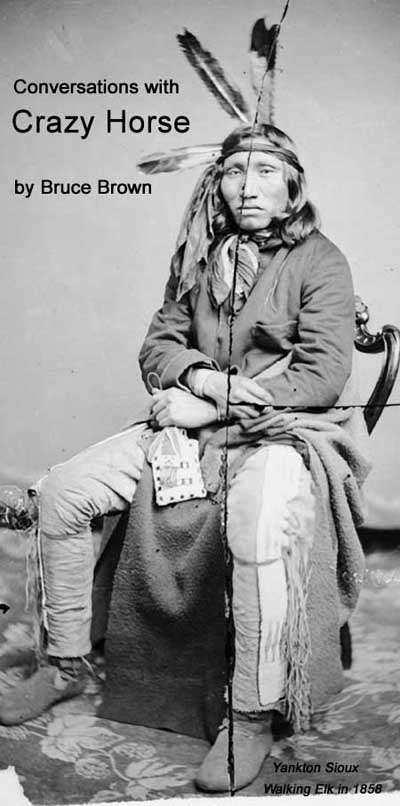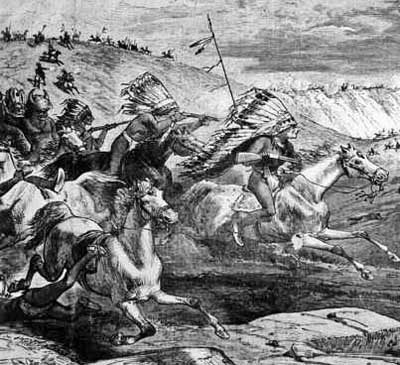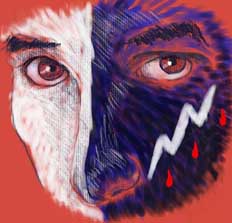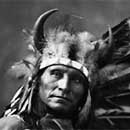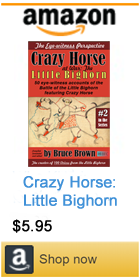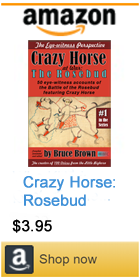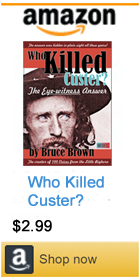One of them, Lazy White Bull, later recalled, "We others wasted no time. Our hearts beat rapidly, and we smoked as fast as we could. All around us the bullets were kicking up the dust, and we could hear the bullets whining overhead. But Sitting Bull was not afraid. He just sat there quietly, looking around as if he were at home in his tent, and smoked peacefully." Finally, Sitting Bull cleaned his pipe, put away his gear, motioned to his companions, stood up and nonchalantly strolled away.
Although a stand-off in military terms, the Sioux nonetheless scored a total victory the next day when the Northern Pacific Railroad survey crew bivouacked at Arrow Creek all quit and caught the first train headed east. Apparently they had gotten a good look at the Indians and concluded that a railroad job wasn't worth dying for. The Sioux and Cheyenne counted Arrow Creek a particularly sweet triumph since it neatly checked all further American railroad incursion into the Yellowstone for a year with virtually no Indian casualties.
Even though others like Lazy White Bull had lots to say about the Battle of Arrow Creek, Crazy Horse was typically silent. He was known for not boasting about his deeds, or making public speeches of any sort. The longest recorded statement by him is barely 200 words, and appropriately enough the utterance most associated with him is the two word Lakota war cry, "hoka hey" or ho'ka hey, which you can see variously translated as...
Today is a good day to die.
Welcome to the soul.
Hold fast. There is more.
Charge!
Crazy Horse may (or may not) have shouted this common Sioux war cry as he and his men galloped into the Battle of the Little Bighorn -- or the Battle of the Greasy Grass as the Sioux called it -- and he may (or may not) have spoken it to Little Big Man just before he was murdered by an American soldier at Fort Robinson. With Crazy Horse it's always possible that he never really said it at all. Study Crazy Horse long enough, and you realize that the flickering is a fundamental part of the man's visage.
In truth, the sound that probably best conveys the spirit of Crazy Horse is not even human at all. It's the raptor-like scream of his eagle bone war whistle -- called an Eagle Horn by the Sioux -- which he only blew on the battlefield in moments of extreme urgency, like the Horn of Roland.
U.S. General Nelson Miles and his troops heard the unearthly piping of Crazy Horse's Eagle Horn at the Battle of Wolf Mt. just before the Indians' final ferocious attack, in what proved to be Crazy Horse's final battle.
WHAT DO WE know for sure about Crazy Horse?
The most salient public fact is probably the combined mortality rate of the U.S. Army soldiers at the Fetterman Massacre on the Powder River in 1866 and the "Custer Fight" on the Little Bighorn River in 1876. Close to 300 Americans died in these two battles, or 100 percent of the total U.S. troops directly engaged.
If Red Cloud was the most strategically successful Indian military leader of the Plains Indian Wars, Crazy Horse the most tactically lethal. If you were an American soldier and you got close enough to see the lightning bolt on Crazy Horse's face, your chances of surviving were pretty slim, statistically speaking.
Unlike many of the Sioux, who fought in elaborately feathered and beaded buckskin regalia that made them look like fearsome glittering birds of prey, Crazy Horse wore only painted spots on his dust-darkened body, a breechclout, a small stone tied behind one ear, and a single hawk feather in his headband.
He typically took three horses with him into battle -- in order to have spare mounts to replace wounded or tiring steeds -- but he was associated for many years with a sorrel gelding, and after that a paint gelding, which he rode against Crook at the Rosebud and Custer at the Little Bighorn.
He didn't take scalps, but he counted coup almost beyond reckoning in the Sioux's incessant wars against the Crows, Snakes, Shoshonis, Omahas and others, wars driven by competition for the buffalo herds which were already withering all along the line of American civilization's westward advance.
On the battlefield, Crazy Horse was renowned for his tactical brilliance and physical bravery, as well as his ruthlessness toward the American invaders. He had seen with his own eyes what trusting the Americans got you -- howitzer shrapnel in the belly and mutilated women, children and old men, the Indian trophy Indian body parts sold at high price among virtuous Americans in Virginia City and Denver.
For his part, General Phil Sheridan, U.S. Army Commander in the West, was widely credited with saying "the only good Indian is a dead Indian." It didn't matter that he denied it for the rest of his life. Everybody got the message plenty clear, and in fact the famous fillip fairly well matches the American Army's marching orders toward the "hostiles" on numerous occasions, as in the Americans' 1865 campaign against the Sioux, when General Patrick E. Connor told his men: "You will receive no overtures of peace or submission from the Indians, but will attack and kill every male Indian over twelve years old."
So Crazy Horse fought, fought as few in history have fought, against an evil and overwhelming invader foe, winning every battle and yet irrevocably losing the war because American forces commanded by President Ulysses S. Grant, General William T. Sherman and Gen. Phil Sheridan were waging a wicked new kind of Total Warfare against the land itself: destroying the natural wealth of the Great Plains -- the vast herds of tatanka, or American buffalo -- to defeat the free Sioux, just as they had destroyed the natural wealth of Georgia and the Shenandoah Valley a decade prior to defeat the Confederacy when they were similarly unable to win a military victory.
Crazy Horse's last battle with the U.S. Army, the Battle of Wolf Mt. on January 8, 1877, showed all the elements in high relief. Many in Crazy Horse's winter camp on the Tongue River in what is now eastern Montana were hungry, and every day there were more mouths to feed as survivors of American attacks elsewhere joined Crazy Horse. Then on January 7, U.S. Army troops under the command of General Nelson Miles took up a position nearby.
Crazy Horse did not want to fight, and in actual point of fact, could not afford to fight. But when he realized Miles -- known as Bear Coat to the Sioux -- was approaching with 400 soldiers, he did what he always did. He attacked. Riding along the Tongue River through heavy snow toward the American soldiers' camp, Crazy Horse divided his Sioux and Cheyenne force of 400 warriors with the plan to decoy and ambush the Americans as he had done so successfully at the Fetterman Massacre, but the decoys could not keep to the plan, and so the element of surprise was lost.
This forced Crazy Horse to fight on the ground Gen. Miles choose for his defensive position, the promontory called Battle Butte which commands a sweeping view of the Tongue River valley and is protected in part by steep cliffs. The Indian attack came shortly after dawn on January 8. Crazy Horse's Cheyenne and Sioux hammered the Miles frontal defense for a couple hours, probing hard for any weakness in the Army line. The action was so thick that one American soldier, Leopold Holeman, later recalled, "My gun barrel was sizzling hot."
Meanwhile, the original attack plan now discarded, Crazy Horse improvised. Looking at Miles' position, the Sioux war chief quickly realized that its principal weakness lay in the mesas above and behind it. Whoever controlled those rocky pinnacles would control the outcome of the battle. And so, while most of Miles' men were busy fighting for their lives in the valley below, Crazy Horse moved a strong contingent of his men into position in the rocks above and behind Miles.
Sometime around mid-morning, Miles came to a realization of his own -- that he was almost completely surrounded by Crazy Horse's warriors. General Miles, meet Crazy Horse. By Miles's own reckoning, a portion of his command was at immediate risk of complete annihilation. He later recalled how Crazy Horse's warriors "would leave their horses behind bluffs, and advance on foot, rifle in hand, filling every ravine and lining every crest."
A professional soldier and experienced Indian fighter, Miles noted that the Battle of Wolf Mt. "was unlike any other Indian fight I ever witnessed, it was fought on ground... [T]hey [Crazy Horse's troops] fought entirely dismounted, not a single rifle being fired on horseback." General Miles, again, meet Crazy Horse. In fact, Crazy Horse fully understood the tactical roll of mounted light infantry, and he taught his men to fight that way when he ordered it.
It took Crazy Horse about two hours to seize control of the battle at Wolf Mt. and turn the tables on the Americans. Now Crazy Horse forced Miles to attack the Indians on the ground Crazy Horse chose, which Miles promptly did, ordering in his reserves and commencing a full frontal assault on the Indians' defense in the mesas. Miles also ordered his artillery to about face from their grand view of the valley below and pound Crazy Horse's positions in the rocks behind.
After more than four hours of constant, frequently heated battle, the American soldiers started running dangerously low on ammunition, and the Indians were in even worse shape. Many Indians, in fact, were entirely out of ammunition for their guns, leaving them only their traditional weapons, the bow and arrow, war club and knife. The battle began to take on a grim flavor. The two armies had chewed each other up pretty well, and now each side pressed to end it in the grey winter light. It was the killing time.
When the Americans attacked the second of the Indians' three rings of defense, a majestic spectacle was enacted in the rocks above. Big Crow, a famous Northern Cheyenne medicine man, appeared in bright red garb with a long eagle feather war bonnet that touched the ground. Declaring himself invincible to the American's bullets, he shot his gun, hurled insults at the U.S. soldiers, and otherwise performed to boost the morale of the Sioux and Cheyenne warriors.
Several times he repeated this routine, ducking under cover of the rocks between sets to visit with friends and supporters. Wooden Leg, a Cheyenne warrior who was there, recalled: "He used up his cartridges and came back to us hidden behind the rocks, to ask for more. Cheyennes and Sioux here and there each gave him one or two or three. He soon got enough to fill his belt."
Meanwhile the battle raged on below, with the Indians slowly but steadily giving up ground in the face of superior American firepower, which was effectively increased by Big Crow's theatrical drain on the short Indian supply. When the Americans finally took the Indians' second ring of defense, and Big Crow was killed by a U.S. Army marksman firing from a distance of 200 yards, the Cheyenne crumpled. They didn't want to fight any more that day, but Crazy Horse's Sioux did not crumple.
At that moment, with the battle hanging in the balance, the valley filled with a strange shrill cry, a wild thing that naturally commanded the attention of all beings within hearing. It was Crazy Horse's Eagle Horn calling all his men -- perhaps as many as 200 at that point -- to listen to him, to follow his command, and the command that he gave was to boldly attack Miles' flank, which was at that moment the American's weak point, and the last place Miles expected to be hit. General Miles, yet again, I give you Crazy Horse.
Crazy Horse's men charged, and the Lakota grappled the U.S. Army at close quarters, knifes and stone axes against Remmington and Spencer firearms. Meanwhile, on the other side of the battlefield, Miles' two hard-working artillery pieces drove the Indians back from their third and final defensive line in the mesas, giving the Americans control of the rocky pinnacles. Then the blizzard hit, and the Indians withdrew into the swirling snow as temperatures dropped to 30 below zero.
The Battle of Wolf Mt. ended a draw in military terms, but not a draw like the Battle of Arrow Creek five years before. At Arrow Creek, a tactical draw won the Sioux a significant strategic victory. At the Battle of Wolf Mt., a tactical draw amounted to a crushing strategic defeat, and signaled the end of the war.
Afterwards Crazy Horse knew he could not continue this holy war against the hated Americans any more, at least under these conditions, with not enough guns and bullets, not enough food and medicine, not enough healthy and able men, not enough protection for the woman and children and aged.
So he surrendered, the last thing the Americans ever expected him to do. But that was Tasunka witko: boldly unpredictable, and for enemies of the Sioux and Cheyenne -- and Americans in particular -- mortally dangerous. Everything, in short, the name Crazy Horse suggests.
AND SO WE COME to the night in October, not too many years after the turn of the 21st century, when I was laboring with digital indigo washes and synthetic pencil cross-hatch overlays to capture the imagined war paint and eyes of Crazy Horse, as if he was looking right at me.
Casually musing to myself, I asked the war-painted face on the screen before me...
When you were alive, you never let the Americans steal your soul. Not many people can say that. Why are you talking to me, of all people, right now?
I never consciously intended or expected anything at all. I was just idly BSing with myself while I worked. Then Crazy Horse answered...
Because you hear me.
Holy You Know What and the Other Stuff too. I just about tipped over the computer table. It was as if someone or some thing was taking over my mind, or least had direct access to my personal thoughts. Very, very strange and unsettling experience, although I'm not sure it really was an "experience" at all.
Mentally speaking, the whole thing had the flavor of raw, unsweetened rhubarb. I sat very quietly for a long time, all mentally puckered up and hugging my computer monitor, which thankfully had not crashed to the floor. Finally, I took a deep breath.
Whew. Don't know what that was all about, I thought to myself, but it feels like it's over. Another deep breath. OK. Good. Nervous laugh. Let's see now, where was I? Long pause. Oh yea, time for bed!
I let go of the computer monitor with a dramatically self-conscious flourish. Then Crazy Horse said...
You are called Many Mouths here. I will call you Many Mouths.
Right then I KNEW I should just let it go -- just SHUT UP -- just make my mind a peaceful garden, but somehow I couldn't stop myself from asking...
My name is spoken in the Land of the Dead?
My god, I immediately thought to myself, where did THAT come from? Did one part of my clearly addled mind just ask an even more addled part something about the Land of the Dead? I gotta stop thinking, I thought. Might have to stop drinking that cheap Canadian beer too. Time for bed, right now!
But I didn't move a muscle. I was frozen by a sound in my mind. This time what I heard wasn't spoken words. It was a white rattle that could have been the wind in big cottonwood leaves along the river at dusk, or a far-away, half-turned laugh, and Crazy Horse said
Everyone's name is spoken in the Land of the Dead!
Next Chapter....
Revised June 1, 2010
"Conversations With Crazy Horse" © Copyright 2006 - 2010 Bruce Brown
|





